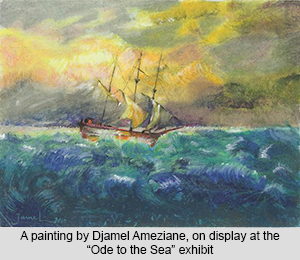
The artwork the Trump administration doesn’t want you to see
People detained in Guantanamo have made and released art for many years without incident, and a number of pieces of detainee artwork are part of the ongoing exhibit, Ode to the Sea, at the John Jay College of Criminal Justice in NYC. CCR clients Djamel Ameziane and Ghaleb Al-Bihani both have works on display.
The exhibit, which has been up since October, has not only drawn widespread media attention, but the attention of the U.S. military, which has declared that it will no longer allow any artwork to be released from the prison. According to media reports, the government even contemplated burning it.
This new policy has been met with public criticism, including a petition launched by the exhibit's curators. On Tuesday, the National Coalition Against Censorship, PEN America, and others issued a statement in response to the new government policy: "The only purpose it appears to serve is to block the American public's access to detainees' artistic expression and stifle the public's full participation in a national conversation about the US government's policies in Guantanamo. Recognizing that the detainees at Guantanamo Bay, most of whom remain held without charge, possess human imagination may inspire an uncomfortable empathy, but Americans have a right to fully examine their government's policies and their effects."
While the government has clarified that it will archive the art, and not burn it, it still stands that art will not be allowed to leave Guantanamo.
For Djamel and Ghaleb, and so many other prisoners, art has been a way to live at and through Guantanamo, and also to connect to the outside world. They would send their artwork to families through the Red Cross and to their lawyers.
"For many years we, Guantanamo prisoners, were pictured by many US government officials, as monsters…the worst of the worst, and I am sure many Americans believed that. Displaying the art work is a way to show people that we are people who have feelings, who are creative, that we are human beings, we are normal people and not monsters," Djamel wrote explaining why he wanted to show his artwork.
If you're in NYC, be sure to check out the Ode to the Sea exhibit, on display through January 28.
|



